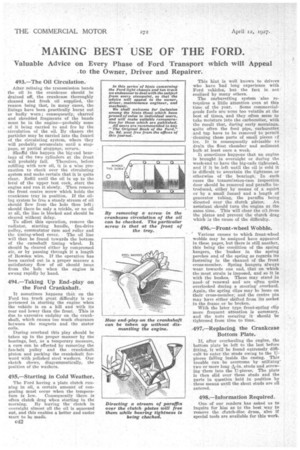MAKING BEST USE OF THE FORD.
Page 64

If you've noticed an error in this article please click here to report it so we can fix it.
Valuable Advice on Every Phase of Ford Transport which will Appeal .to the Owner, Driver and Repairer.
493.—The Oil Circulation.
After relining the transmission bands the oil in the crankcase should be drained off, the crankcase thoroughly cleaned and fresh oil supplied, the reason being that, in many cases, the linings have been practically burnt out or badly worn ; consequently, charred and shredded fragments of the bands must be in the engine—probably some of it being carried to and fro by the • circulation of the oil. By chance the particles may be carried into the funnel of the circulating system, where they will probably accumulate until a stoppage, or partial stoppage, occurs., • Shcattl this happen the big-end bearings of the two cylinders at the front will probably fair. Therefore, before refilling with new oil, it is a wise precaution to check over the circulating system and make certain that it is quite clear. Refill until the oil is up to the level of the upper teat cock, start the engine and run it slowly. Then remove the front centre screw which holds the crankcase tray in position. If the oiling system be free a steady stream of oil should flow from the hole thus left; should there be only a trickle, or no oil at all, the line is blocked and should be cleared without delay.
To effect this operation, remove the radiator, starting handle, fan-drive pulley, commutator case and roller and the timing-wheel cover. The oil line will then be found towards the bottom of the •camshaft timing wheel. It should be cleared either by compressed air, or by passing through it a length of Bowden wire. If the operation has been carried out in a proper manner a satisfactory flow of oil should issue from the hole when the engine is swung rapidly by hand.
494.—Taking Up End-play on the Ford Crankshaft.
It sometimes happens that on the Ford ton truck great difficulty is experienced in starting the engine when the vehicle is on a hill and with its rear end lower than the front. This is due to excessive endplay on the crankshaft, which causes too much clearance between the magnets and the stator coils.
During overhaul this play should be taken up in the proper •manner by the bearings, but, as a temporary measure, a cure can be effected by removing the fan-belt pulley and the crankshaft pinion and packing the crankshaft forward with polished steel washers. Our sketch shows, diagrammatically, the position of the washers.
495.—Starting in Cold Weather.
The Ford having a plate clutch running in oil, a certain amount of congealing must occur when the tempera
ture is low. Consequently there is often clutch drag when starting in the
morning. By leaving the clutch in overnight almost all the oil is squeezed out, and this enables a better and easier Start to be made. This hint is well known to drivers who have had long experience with Ford vehicles, but the fact is not realized by many others.
The carburetting system also rerequires a little attention even at this
time of the year. Some commercialgrade fuels are none too volatile at the best of times, and they ofte-n seem to take moisture into the carburetter, with the result that, during early mornings, quite often the feed pipe, carburetter and tap have to be removed to permit cleaning these parts of small pieces of ice. It is consequently advisable lo drain the float chamber and sediment bulb at least once a week.
It sometimes happens that an engine is brought in overnight or during the week-end to have the big-ends tightened, arid if it be left until the oil is cold it is difficult to ascertain the tightness or otherwise of the bearings.. In such cases the transmission-ease inspection door should be removed and Paraffin introduced, either by means of a squirt or by a small funnel and a length of generator tubing, the paraffin being directed over the clutch plates. An assistant should turn the engine at the same time. This will clear the oil from the plates and prevent the clutch drag which is the cause of the difficulty.
496.—Front-wheel Wobble.
Various causes to which front-wheel wobble may be assigned have appeared in these pages, but there is still another, this being the condition of the spring hangers, the bushes in the spring perches and of the spring as regards its fastening in the channel of the front cross-member. Spring hangers always wear towards one end, that on which the most strain is imposed, and so it is with the bushes. These may stand in needof renewal and are often quite overlooked during a steering overhaul. Again, the spring clips may be loose on their cross-member; and the centre pin may have either shifted from its socket in the frame or be broken.
With the later type front-spring clip more frequent attention is necessary, and the nuts securing it should be tightened from time to time..
,497.—Replacing the Crankcase Bottom Plate.
If, after overhauling the engine, the bottom plate be left to the last before fitting, it will be found extremely difficult to enter the studs owing to the pieces falling inside the casing. This trouble can be overcome by utilizing' two or more long -A-in. studs and screwing them into the IT-pieces. The plate is then slid over these studs and the parts in question held in position by these means until the short studs are all entered.
498.—Information Required.
One of our readers has asked us to inquire for him as to the best way to remove the clutch-disc drum, also if special tools are available for this work.












































































































